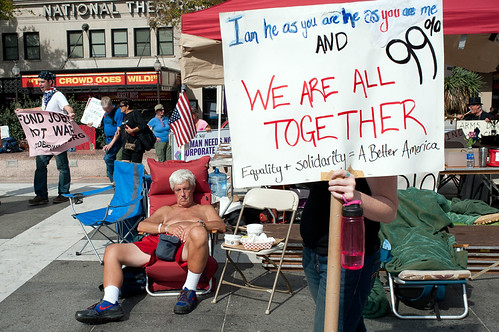Occupy DC in Freedom Square, Pennsylvania Avenue, Washington, DC. Flickr photo by yospyn.
The U.S. protests, like the protests in countries like Algeria and Tahrir Square in Cairo, Egypt, show the necessity of public squares in enabling citizens to "freely assemble" or "petition the government to redress grievances."
As places in the U.S. become more suburbanized without centers, the center cities remain important within the metropolitan landscape as places for organizing and holding events, because there are central places there to gather and concentrate. So says the
New York Times in "
In Protest, the Power of Place."
There is a counter trend to deconcentration in the suburbs, and that is the creation of "Town Centers," which are a mix of mostly commercial but also civic functions.
Depending on the place though, all the space may be privately controlled, which makes having a demonstration, especially one that is 24/7 for many days, out of the question. For example, the Times writes about the Occupy Wall Street movement in New York City, which is on a park called Zuccotti Square, which technically is open to the public as a result of a zoning agreement, but is a private park.
Similarly, controversies over photography in public places that are privately controlled such as Ellsworth Avenue in Silver Spring or Union Station in DC remain an issue.
From the article:
Another reminder came late last week when the landlord of Zuccotti Park, where the demonstrators in New York City have settled, at the last minute withdrew a request for police assistance in cleaning up the park. This, at least temporarily, averted a confrontation in front of the global media over what protesters regarded as just a pretext to evict them.Similarly, Occupy Wall Street protests are happening elsewhere (see "
Anti-Wall St. movement grows to dozens of cities" from the Associated Press), such as in DC, Richmond, Seattle, Los Angeles, etc..
(Of course, DC is still paying out millions of dollars to people arrested illegally--violating their first amendment freedoms--to people who protested in the city in association with anti-IMF-World Bank demonstrations.)
Where would we be without public places? And what do we do as more seemingly public places are commercial, not public? Or the response in civic architecture to harden buildings and create forlorn public squares that have physical conditions making the sites easier to contain and control?
Labels: civic engagement, protest and advocacy, public space management, urban design/placemaking, urban vs. suburban




0 Comments:
Post a Comment
<< Home